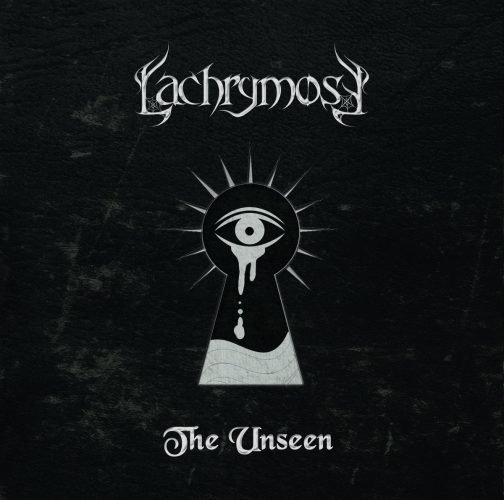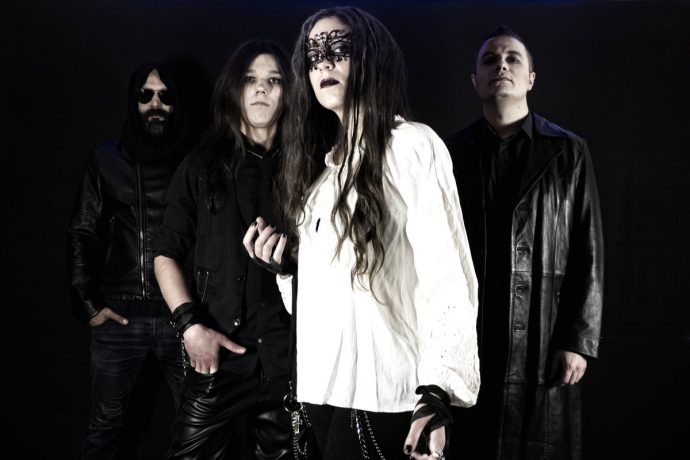(Vasilis Xenopoulos, a guest writer from Greece who has contributed to NCS in the past, rejoins us with this review of the new EP by the Greek band Lachrymose, which was released in May and is an exception to the “rule” in our site’s title.)
Doom metal and tragedy are intertwined. The music, slow and heavy, leads gradually towards redemption and serves as a means for the unfolding of the stories of the pain and woes of man. Doom metal is a dance, a bleak and sorrowful waltz that sings of the suffering of man while at times praises the spirit of revolt and the pursuit of salvation.
In 2015 Lachrymose released the story of a witch who was accused and sentenced to the pyre for the crime of defiance against the dogma of religion. Carpe Noctum is doom metal that brings to mind the aesthetics of Paradise Lost in the times of Gothic and Icon. Through their music we follow her journey, as it is performed by vocalist Hel, from life to death and her return from the dead by a necromancer’s ritual.
But something went terribly wrong. When the thin veil between the living and the dead opened, vengeful spirits passed through and got inside her now living body. Her mind remained in the medium world, between the living and the dead, where everything and nothing is true, where spirits dwell in the fog of the underworld.
The Unseen, released in May, concludes the story in five chapters/songs and it continues from the moment of her resurrection. One could wonder who or what the unseen is. The tormented witch did wake up, but not in the physical world. She woke up inside a dream, a prison cell of the mind, where everything that is seen by her, is unseen by us. She entered the metaphysical realm and became trapped, while her body remained unconscious. The Unseen is her story of liberty through death.
The main riffs bring to mind the traditional doom metal of Candlemass and the gothic atmosphere of Paradise Lost. The drums are robust and steadfast throughout the album, maintaining and changing the pace of the story whenever it is necessary. The bass lines support the guitars while at times they appear in the front, taking the lead. The music can be seen as a communion of sounds with the purpose of supporting the performance of Hel. She plays roles and shifts between the different emotional states of the main character; from the sensitive and frail struggle of keeping herself alive in an unseen and clouded world, to the cynical acknowledgement of her state and her acceptance of what needs to be done.
The first entity she encounters in“The Unseen” is the devil. There is a connection of the devil with Baphomet, the hermaphrodite deity that represents the union of light and darkness, male and female. In such a way, the devil cannot be viewed as the devil itself, but as a complete entity, a goddess. By the end of the song she reveals herself. She is the breath of the world, the Nykteria, the Trioditis. Her name is Hecate, the tripartite goddess, Queen of the World and of the Netherworld. She may be seen at the crossroads of one’s own life, holding the keys to hidden knowledge. (The connection of Baphomet with Hecate was made, in an indirect way, by me since both represent the female energy – the unseen and immaterial attributes of the body – and as deities, they were connected with evil by Christianity.)
Hecate, though, is accompanied with ghosts of the past that torment those who get lost in Her realm. In “This Sickness” – with its excellent drumming and riffs – our hero finds herself floating in an endless void, and her desperation breeds the fire that the lost souls use to madden her. She reacts to her pain and stands on the “altar of her doom” and sees “Nepenthe” – check out the video below – as the way to her salvation. In ancient Greek mythology, Nepenthe was a medicine of forgetfulness, and in our story, the draught is in the chambers of Lethe, the goddess of forgetfulness.
In the “Darkside Waltz”, Hecate is summoned and reveals Herself, offering to our hero the opportunity of everlasting power. The dilemma is Truth – freedom from Lethe — or perfection in the world of the living. Until, of course, the contract is fulfilled and she returns as a servant of Hecate. She rejects her offer and pushes beyond, diving into the river of Lethe, determined to return to the halls of her fathers
The final chapter, “Capricorn Descending (feat. The Dead Creed)”, begins with Macbeth’s soliloquy — act 5 scene 5 — after he learns about the death of Lady Macbeth. With this analogy, we are also informed of the death of our hero, as she lies by the river. But this death signifies the death of the hero’s persona on the stage of a life that was never meant to be fulfilled by her. It was a stage for the metamorphosis from a witch to a heathen, from a child who follows the words of others to an individual who does not bow to any dogma, be it a dogma of light or a dogma of darkness.
She descends as the daughter of Pricus, of the zodiac sign of Capricorn, while she sings for and of her freedom, when she finally returns to her true Father in the skies, and becomes Sophia. (I would like to add here that the name Sophia was given by me, since the witch never identifies herself. I wanted to complete the story in my head and in a way that did not alter the flow of the story. Sophia was never a deity, but a symbol of the female energy in wisdom; a wisdom that can be present both in men and women. In Gnosticism, Sophia represented the left hand and the sister of Christ. At times she was identified with the Holy Spirit, giving the Holy Spirit a bodily and at the same time divine role.)
The EP is a complete story by itself and a successful step for Lachrymose. The production is clear, heavy, giving justice to the work of everyone who took part in the making of this album. The compositions honor doom metal and the band has a lot more to give in the future. Tragedy and doom are meant to work together and The Unseen is proof of that.
Bandcamp:
https://lachrymoseband.bandcamp.com/
Facebook:
https://www.facebook.com/Lachrymose.band.official/


